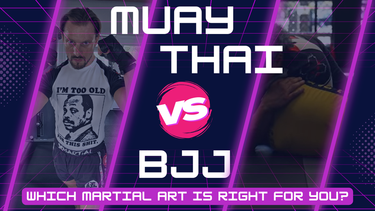
Choosing between Muay Thai and Brazilian Jiu-Jitsu (BJJ) isn’t just about picking a sport—it’s about deciding how you want to train, defend yourself, and build both body and mindset. Below, you’ll find a decision-focused guide that compares both arts in practical terms so you can choose with confidence.
What Are the Key Differences Between Muay Thai and BJJ?
- Muay Thai is a striking martial art from Thailand. It’s called the Art of Eight Limbs because it uses fists, elbows, knees, and shins.
- BJJ (Brazilian Jiu-Jitsu) is a grappling martial art from Brazil. It focuses on submissions, chokes, and joint locks on the ground.
Insight:
- If you want to strike, kick, and dominate standing up → Muay Thai fits.
- If you want to control, submit, and win on the ground → BJJ is your path.
Which Martial Art Is Better for Self-Defense?
Muay Thai for self-defense:
-
Strong for multiple attackers and quick stand-up exchanges.
-
Elbows and knees work well in close quarters.
BJJ for self-defense:
- Strong for one-on-one scenarios.
- Focuses on leverage—smaller individuals can control larger attackers.
- Submissions give you non-lethal control.
Insight:
- If your concern is street defense against more than one person → Muay Thai gives mobility and striking tools.
- If your concern is being pinned or grabbed → BJJ teaches you how to escape and dominate on the ground.
Which Is Better for Fitness and Conditioning?
- Muay Thai training → intense cardio, pad work, bag work, clinch drills, sparring. Builds stamina, explosiveness, and lean muscle.
- BJJ training → live rolling, drilling, positional sparring. Builds functional strength, endurance, flexibility, and mental resilience.
Insight:
- Want high-calorie burn, agility, striking speed? → Muay Thai.
- Want full-body conditioning, grip strength, problem-solving under stress? → BJJ.
What About Competition Rules and Training?
- Muay Thai competition → 3–5 rounds, 3 minutes each. Points scored by clean strikes, knockdowns, and ring control. KO/TKO possible.
- BJJ competition → 5–10 minutes, scored on takedowns, guard passes, mount. Submission ends the match instantly.
Insight:
- If you enjoy intensity, striking, and endurance battles, Muay Thai matches your mindset.
- If you enjoy technical chess-like battles, positional control, and tactical submissions, BJJ suits you.
Which Martial Art Is Safer or Riskier?
- Muay Thai risks → concussions, bruising, shin/knee injuries from striking.
- BJJ risks → joint injuries, neck/back strains, slower accumulation but can be serious if submissions aren’t respected.
Insight:
- If you’re worried about head trauma → BJJ has less striking impact.
- If you want less time on the ground and more striking → Muay Thai.
Muay Thai vs BJJ: Essential Gear
Muay Thai Gear
- Gloves: Muay Thai gloves are specifically designed for striking sports, with thicker padding and a more closed-fist design compared to boxing gloves.
- Shorts: Muay Thai shorts are typically loose-fitting and made from breathable materials to allow for maximum mobility.
- Shin Guards: Shin guards are essential for protecting your shins during training and sparring. Muay Thai shin guards are designed to be lightweight and provide adequate protection.
- Hand Wraps: Hand wraps are used to protect your hands and wrists during training and sparring.
BJJ Gear
- Gi: A BJJ Gi consists of a jacket and pants. BJJ Gis are typically made from lightweight, breathable materials and have a looser fit than judo gis.
- Rash Guard: BJJ Rash guards are compression garments worn underneath the gi to provide comfort, protection, and moisture-wicking properties.
- Mouthguard: A mouthguard is essential for protecting your teeth and jaw during training and competition.
- Belt: Belts are used to indicate rank and proficiency in BJJ.
Which Martial Art Works Better for Kids?
Both build discipline, focus, and respect.
- Muay Thai kids’ training → builds coordination, reflexes, and self-confidence through striking.
- BJJ kids’ training → builds patience, problem-solving, and self-defense without excessive striking.
Insight:
- Parents who value confidence and agility → Muay Thai.
- Parents who want safety and bully-proof skills → BJJ.
Pros and Cons of Each Martial Art
Muay Thai Pros
- Explosive striking power
- Excellent conditioning
- Strong for self-defense in multiple-attacker situations
Muay Thai Cons
- Higher risk of head injuries
- Demands high cardio and durability
BJJ Pros
- Technique > strength (size doesn’t matter as much)
- Safer on the head (no striking)
- Strong one-on-one self-defense
BJJ Cons
- Less effective against multiple attackers
- Steeper learning curve—progress may feel slow
Final Decision: Which Martial Art Should You Choose?
- Choose Muay Thai if → You want striking, intensity, explosive workouts, and fast self-defense skills.
- Choose BJJ if → You want grappling, submissions, mental strategy, and self-defense for one-on-one scenarios.
- Choose Both if → You want to cover every situation, blending striking and grappling into a complete MMA skillset.






